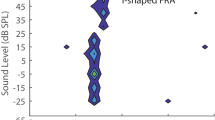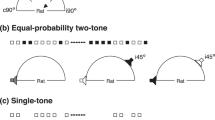Abstract
The neural response to amplitude-modulated sinus sounds (AM sound) was investigated in the auditory cortex and insula of the awake squirrel monkey. It was found that 78.1% of all acoustically driven neurons encoded the envelope of the AM sound; the remaining 21.9% displayed simple On, On/Off or Off responses at the beginning or the end of the stimulus sound. Those neurons with AM coding were able to encode the AM sound frequency in two different ways: (1) the spikes followed the amplitude modulation envelopes in a phaselocked manner; (2) the spike rate changed significantly with changing modulation frequencies. As reported in other species, the modulation transfer functions for rate showed higher modulation frequencies than the phaselocked response. Both AM codings exhibited a filter characteristic for AM sound. Whereas 46.6% of all neurons had the same filter characteristic for both the spike discharge and the phase-locked response, the remaining neurons displayed combinations of different filter types. The discharge pattern of a neuron to simple tone or noise bursts suggests the behaviour of this neuron when AM sound is used as the stimulus. Neurons with strong onset responses to tone/noise bursts tended to have higher phase-locked AM responses than neurons with weak onset responses. The spike rate maxima for AM sound showed no relation to the tone/noise burst discharge patterns. Varying modulation depth was encoded by the neuron's ability to follow the envelope cycles and not by the non-phase-locked spike rate frequency. The organization of the squirrel monkey's auditory cortex has previously been established by an anatomical study. We have added two new fields using physiological parameters. All fields investigated showed a clear functional separation for time-critical information processing. The best temporal resolution was shown by the primary auditory field (AI), the first-temporal field (T1) and the parainsular au ditory field (Pi). The neural data in these fields and the amplitude modulation frequency range of squirrel monkey calls suggest a similar correlation between vocalization and perception as in human psychophysical data for speech and hearing sensation. The anterior fields in particular failed to follow the AM envelopes. For the first time in a primate, the insula was tested with different sound parameters ranging from simple tone bursts to AM sound. It is suggested that this cortical region plays a role in time-critical aspects of acoustic information processing. The observed best frequencies covered the same spectrum as AI. As in the auditory fields, most neurons in the insula encoded AM sound with different filter types. The high proportion of neurons unable to encode AM sound (40.6%) and the low mean best modulation frequency (9.9 Hz) do not support a prominent role of the insula in temporal information processing.
Similar content being viewed by others
References
Augustine JR (1985) The insular lobe in primates including humans. Neurol Res 7:2–10
Bieser A, Müller-Preuss P (1989) Temporal processing through auditory neurons: periodicity decoding and spike rate. Eur J Neurosci [Suppl 2]:260
Bieser A, Müller-Preuss P (1991) Physiological and cytoarchitectonic characterization of auditory responsive cortical areas in the awake squirrel monkey. Eur J Neurosci [Suppl 4]:42
Bieser A, Müller-Preuss P (1992) Organization of the auditory cortex in the squirrel monkey. In: Elsner N, Richter DW (eds) Rhythmogenesis in neurons and networks. Thieme, Stuttgart
Burton H, Jones EG (1976) The posterior thalamic region and its cortical projection in New World and Old World monkeys. J Comp Neurol 168:249–302
Clarey CC, Barone P, Imig T (1992) Physiology of thalamus and cortex. In: Popper AN, Fay RR (eds) The mammalian auditory pathway: neurophysiology. Springer, Berlin Heidelberg New York, pp 233–334
Emmers R, Akert K (1963) A stereotactic atlas of the brain of the squirrel monkey. University of Wisconsin Press, Wisconsin
Fastl H (1982a) Fluctuation strength and temporal masking patterns of amplitude modulated broadband noise. Hear Res 8:59–69
Fastl H (1982b) Beschreibung dynamischer Hörempfindungen anhand von Mithörschwellenmustern. Hochschul, Freiburg
Fastl H, Hesse A, Schorer E, Urbas J, Müller-Preuss P (1986) Searching for neural correlates of the hearing sensation fluctuation strength in the auditory cortex of squirrel monkeys. Hear Res 23:199–203
Fastl H, Widmann U, Müller-Preuss P (1991) Correlations between hearing and vocal activity in man and the squirrel monkey. Acustica 73:35–36
Imig TJ, Ruggero MA, Kitzes LM, Javel E, Brugge JF (1977) Organization of auditory cortex in the owl monkey (Aotus trivirgatus). J Comp Neurol 171:111–128
Jones EG, Burton H (1976) Areal differences in the laminar distribution of thalamic afferents in cortical fields of the insular, parietal and temporal regions of primates. J Comp Neurol 168:197–248
Kelly JB (1973) The effects of insular and temporal lesions in cats on two types of auditory pattern discrimination. Brain Res 62:71–87
Langner G, Schreiner CE (1988) Periodicity coding in the inferior colliculus of the cat. I. Neuronal mechanisms. J Neurophysiol 60:1799–1822
Luethke LE, Krubitzer LA, Kaas JH (1988) Cortical connections of electrophysiological and architectonically defined subdivisions of auditory cortex in squirrels. J Comp Neurol 268:181–203
Maurus M, Streit K-M, Geissler B, Barclay D, Wiesner E, Kuehlmorgen B (1984) Categorical differentiation in amplitude changes of squirrel monkey calls. Lang Commun 4:195–208
Merzenich MM, Brugge JF (1973) Representation of the cochlear partition on the superior temporal plane of the macaque monkey. Brain Res 50:275–296
Morel A, Kaas JH (1992) Subdivisions and connections of auditory cortex in owl monkeys. J Comp Neurol 318:27–63
Mufson EJ, Mesulam MM (1984) Thalamic connections of the insula in the rhesus monkey and comments on the paralimbic connectivity of the medial pulvinar nucleus. J Comp Neurol 227:109–120
Müller-Preuss P, Bieser A, Preuss A (1986) Processing of amplitude modulated sounds in the auditory pathway of squirrel monkeys. Neurosci Lett [Suppl]26:406
Müller-Preuss P, Bieser A, Preuss A, Fastl H (1988) Neural processing of AM-sounds within central parts of the auditory pathway. In: Syka J, Masterton B (eds) Auditory pathway: structure and function. Plenum, New York, pp 327–331
Müller-Preuss P, Flachskamm C, Bieser A (1994) Neural encoding of amplitude modulation within the auditory midbrain of squirrel monkeys. Hear Res 80:197–208
Preuss A, Müller-Preuss P (1990) Processing of amplitude modulated sounds in the medial geniculate body of squirrel monkeys. Exp Brain Res 79:207–211
Schott D (1975) Quantitative analysis of the vocal repertoire of squirrel monkeys (Saimiri sciureus). Z Tierpsychol 38:225–250
Schreiner CE, Langner G (1988) Periodicity coding in the inferior colliculus of the cat. II. Topographical organization. J Neurophysiol 60:1823–1840
Schreiner CE, Urbas JV (1986) Representation of amplitude modulation in the auditory cortex of the cat. I. The anterior auditory field (AAF). Hear Res 21:227–241
Schreiner CE, Urbas JV (1988) Representation of amplitude modulation in the auditory cortex of the cat. II. Comparison between cortical fields. Hear Res 32:49–64
Sudakov K, MacLean PD, Reeves A, Marino R (1971) Unit study of exteroceptive inputs to claustrocortex in awake, sitting, squirrel monkey. Brain Res 28:19–34
Terhardt E (1968) Über akustische Rauhigkeit und Schwankungsstärke. Acustica 20:215–224
Winter P, Funkenstein HH (1973) The effect of species-specific vocalization on the discharge of auditory cortical cells in the awake squirrel monkey (Saimiri sciureus). Exp Brain Res 18:489–504
Woolsey CN, Walzl EM (1982) Cortical auditory area of Macaca mulatta and its relation to the second somatic sensory area (Sm-II): determination by electrical excitation of auditory nerve. In: Sachs MB (ed) Cortical sensory organization, vol 3, Multiple auditory areas. Humana Press, Clifton, NJ, pp 231–256
Author information
Authors and Affiliations
Rights and permissions
About this article
Cite this article
Bieser, A., Müller-Preuss, P. Auditory responsive cortex in the squirrel monkey: neural responses to amplitude-modulated sounds. Exp Brain Res 108, 273–284 (1996). https://doi.org/10.1007/BF00228100
Received:
Accepted:
Issue Date:
DOI: https://doi.org/10.1007/BF00228100




